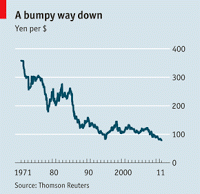Buttonwood: Forty years on

The Economist
FORGET Watergate. For economic historians, Richard Nixon’s place in history is secure. He was the president who, 40 years ago, severed the link between global currencies and gold and ended the fixed-exchange-rate system.
Under the Bretton Woods regime, world currencies were pegged to the dollar, which in turn was tied to a set price of gold. Central banks had the right to convert their dollar holdings into bullion. But on August 15th 1971 Nixon, in the face of economic difficulties, closed the gold window, devalued the dollar against bullion and imposed a 10% surcharge on imports. The era of paper money and floating exchange rates had arrived.
However, currency crises didn’t go away. In part, that was because the move to floating rates was not complete. The Europeans did not like leaving their currencies to the whims of the markets and made several efforts to limit exchange-rate flexibility within the EU, culminating in the adoption of the euro. The eventual effect was to move financial volatility from the currency to the bond markets, with uncompetitive countries facing higher borrowing costs rather than pressure on their exchange-rate pegs.
The inflexibility of currency pegs has long been cited as a reason for having floating rates. Milton Friedman, a monetarist economist, argued that adjustments were easier in a floating-rate system. In his book, “Essays in Positive Economics”, published in 1953, he wrote that: “It is far simpler to allow one price to change, namely the price of foreign exchange, than to rely upon changes in the multitude of prices that together constitute the internal price structure.”
The Bretton Woods founders had believed that floating rates would be dangerously unstable. But Friedman argued that, provided sensible policies were followed, speculators would act as a stabilising force, preventing currencies from departing too far from fair value.
In fact, exchange rates have been more volatile than Friedman might have expected. The chart shows the dollar versus the yen; although the overall trend has been one of dollar decline, there have been some sharp swings along the way. Despite a notional commitment to floating rates, there have been several bouts of intervention; the latest came on August 4th, when the Japanese tried to drive down their currency. The impact was spoiled when Standard & Poor’s cut America’s credit rating, sending the dollar back down.
The move to floating rates has also had some interesting side-effects. The Bretton Woods system had strict capital controls, designed to protect the exchange-rate pegs. But these became unnecessary in an era of floating rates. As they were abandoned in the early 1980s, capital started flowing round the world at an ever faster rate, with the finance sector taking a cut at every stage. It is surely no coincidence that the rise in the relative wages of financial professionals began at that point.
In addition, the central banks of free-floating currencies no longer had to raise interest rates to defend their exchange rates. Indeed, markets were more tolerant of countries with trade deficits than they were under Bretton Woods. Without the trade constraint, the way was made clear for “the Greenspan put”: the use of interest-rate cuts to rescue financial markets, in effect underwriting asset prices.
By contrast, there were no asset bubbles to speak of in the Bretton Woods era and (not coincidentally) scarcely any financial crises. Between 1945 and 1971, the worst calendar-year loss suffered on Wall Street was a 14.1% decline in 1957.
Perhaps the lesson of the past 40 years is that neither a fixed nor a floating-rate system is a panacea. Many governments have used currency pegs as a shortcut towards economic credibility without the structural reforms needed to ensure their economies remained competitive. Floating rates create the temptation for governments to drive down their currencies and grab a bigger share of world trade. That temptation is very strong at the moment and could lead to further political tensions if America opts for another round of quantitative easing. In a world of competing devaluations, gold keeps driving higher. It surged above $1,800 an ounce on August 11th. In terms of the old gold measure, the dollar has devalued by 98% since the end of the Bretton Woods era.
- Ben Bernanke: Currency Manipulator
By MARY ANASTASIA O'GRADY. WSJ The dollar is our currency, but it's your problem.—U.S. Treasury Secretary John Connally, 1971In the final televised presidential debate, Mitt Romney promised that if he is elected on Nov. 6 he will "label China...
- What's Behind Brazil's Slow Growth?
By MARY ANASTASIA O'GRADY, WSJ Along with Russia, India and China, Brazil is supposed to be a 21st century economic tiger. So how come it grew a measly 2.7% last year? President Dilma Rousseff would have you believe that it is because the Federal...
- O Sábio Profeta
Q: Thank you very much. Before we sign off, could I just take the opportunity to ask you what you think the prospects are for the attempts in Europe to create a common currency area? Are you optimistic about their success? A: I think it's a big...
- Blurring The Mandate
The Economist Is the Central Bank targeting growth? FOR much of the last century inflation was as prominent a feature of Brazilian life as football. It was finally tamed, first by the Real Plan of 1994 involving a new currency and fiscal measures, and...
- Buttonwood: The Lowdown
The Economist BOND-MARKET vigilantes have a ferocious reputation but it turns out they can be very forgiving. Although Standard & Poor’s has downgraded America’s credit rating and the 2011 budget deficit is expected to be 9% of GDP, the Treasury...
